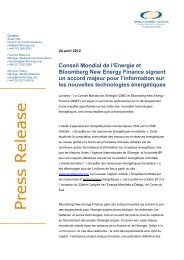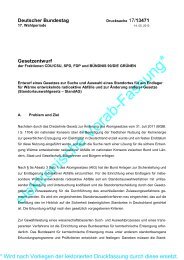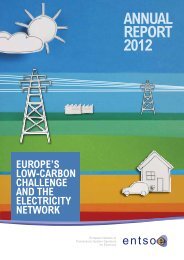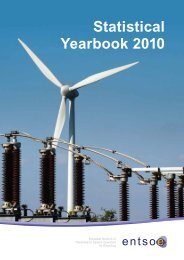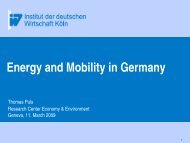Performance of Generating Plant - World Energy Council
Performance of Generating Plant - World Energy Council
Performance of Generating Plant - World Energy Council
You also want an ePaper? Increase the reach of your titles
YUMPU automatically turns print PDFs into web optimized ePapers that Google loves.
8<strong>Performance</strong> <strong>of</strong> <strong>Generating</strong> <strong>Plant</strong>: Managing the Changes Executive Summary <strong>World</strong> <strong>Energy</strong> <strong>Council</strong> 2007Figure 3 Wind power installed in 2006 (MW) – Top 12 countriesSource: Systémes Solaires – Observ’ERWind power installed in 2006 (MW) - Top 12 countries20000+12%175001500012500+16% +27%Added in 2006Installed in 20051000075005000250000 %GermanySpain USA India+37%+24% +47% +64% +35% +27%+27% - 2%DenmarkAdded in 2006 (MW) 2,233 1,587 2,454 1,619 11 417 631 673 439 336 767 -22Installed in 2005 (MW) 18,415 10,028 9,149 4,434 3,129 1,718 1,332 1,047 1,260 1,224 684 1,150ItalyUKPortugalChinaNetherlandsCanada Japan• Consolidation in the nuclear industry,which also means that more plants areoperated by those who do it best.Technical, Commercial andSociological Indicators forRenewable EnergiesWind energy: a dynamic sectorSince the early 1990s, wind power hasundergone a considerable level <strong>of</strong> development.In 1995, the total global installed wind powercapacity was 5,000MW. Ten years later, in2005, the installed capacity reached 59,200MW,including 11,700 MW added during the year (i.e.a growth rate <strong>of</strong> 25%). In 2006, the firststatistics show a total capacity <strong>of</strong> 72,600MW(13,400MW installed during the year, i.e. 23%growth rate).Germany is the leader with more than20,600MW installed in 2006 i.e. nearly one third<strong>of</strong> the world-wide wind power capacity, followedby Spain with 11,615MW, the United States with11,600MW, India with 6,050MW and Denmarkwith 3,140MW. These five countries accountedfor nearly 75% <strong>of</strong> the global capacity in 2006.Over the past two decades, the power outputand the size <strong>of</strong> wind turbines have beenincreasing significantly. This growth is nowslower for onshore turbines. Typical moderngrid-connected wind turbines have diameters <strong>of</strong>40 to 90 metres, towers <strong>of</strong> 50 to 100 metres highand are rated between 500kW and 3MW(average: 1.85MW in Germany in 2006).Their excellent technical availability isbetween 95 and 99%. However, theircapacity factor (ratio <strong>of</strong> the total actualenergy production over the potential energyproduction) is impaired by windintermittence, as wind availability variesbetween 20 and 30% for onshore; and up to40% for <strong>of</strong>fshore farms.Currently the most powerful turbine is rated at6MW with a rotor diameter <strong>of</strong> 115 metres and atower <strong>of</strong> 125 metres. The 3-6 MW wind turbinesare in fact mainly intended for <strong>of</strong>fshoreinstallations.Wind turbines are designed to work for some120,000 hours <strong>of</strong> operation throughout a lifetime<strong>of</strong> about 20 years. It is now technically feasibleto build wind turbines at water depths over 30metres and far <strong>of</strong>fshore.Nevertheless such installations are expensive,and most <strong>of</strong>fshore wind farms are located inshallower waters within 18km from shore. In2005, a new <strong>of</strong>fshore wind capacity <strong>of</strong> 900MWwas installed in the world.



